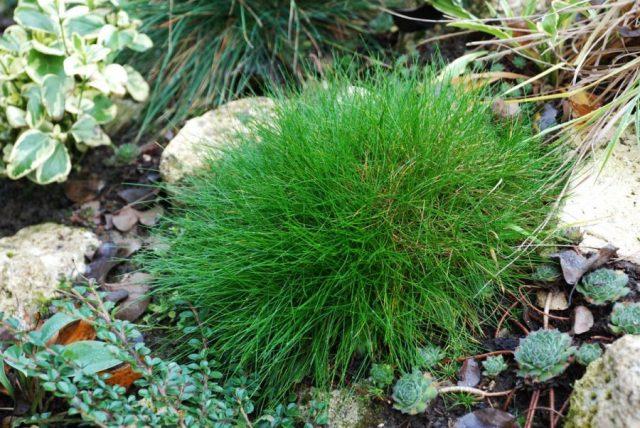Content
Fescue Gautier is an ornamental unpretentious plant that is usually used to create a lawn. Before planting a crop on a summer cottage, it is worth studying its requirements and features.
History of appearance
Festuca gautieri (Festuca gautieri) is an evergreen perennial plant with a rich history. The exact origins of the culture remain unknown. But the first mentions of it are found in documents from ancient times. Already at that time, fescue was used to decorate recreation areas and gardens. The Pyrenees is considered to be the birthplace of culture.
Breeders began breeding decorative varieties in the 1880-1890s. During this period, there was a demand for special coatings for golf courses. In 1885, fescue was officially recognized as one of the best lawn grasses. Around the same time, numerous varieties of Gauthier's festuka appeared on the market.
Description of fescue Gauthier
Fescue Gautier is a low plant with a compact creeping root system.It has hard, narrow, thread-like leaves reaching 8 cm in length. At the beginning of summer, it throws out panicles up to 40 cm above the ground, on which grayish-green or violet-bronze buds bloom, collected in spikelets. At the end of the decorative period, the flowers acquire a light brown tint. Fescue seeds are thin, long, convex on one side and grooved on the other.

Fescue Gautier spreads up to 60 cm in diameter
Most often, Festuka Gautier has a dark green tint of leaves. But there are also bluish-green and bluish varieties. The ornamental grass continues to bloom until the end of autumn. The plant bears buds for the first time in the second year after planting with seeds. At the same time, in the middle zone, flowering may not take place at all - Gauthier fescue develops much better in warm regions.
Moisture-loving fescue Gautier or drought-resistant
Decorative fescue Gautier has good drought resistance. The grass does not like abundant moisture; it needs to be watered rarely and only during periods of prolonged absence of precipitation. When growing crops, it is necessary to carefully monitor the condition of the soil. When overmoistened, festuka often suffers from fungal diseases.
Frost resistance
Gauthier fescue develops best at a temperature of 15-25 ° C; in the heat it stops its growth. It tolerates winter in the middle zone well, but requires good insulation. In severe frosts, the evergreen leaves of the plant may partially die. At the same time, with the onset of spring, the festuka quickly recovers.
What soils does he prefer?
Festuka Gowthera prefers to grow in poor soil and does not tolerate fertile soil well.Dry or rocky soil with good water and breathability is best suited for decorative perennials. Fescue can be planted on slightly acidic, neutral and slightly alkaline soil, on sandy loam and loam.
Diseases and pests
With proper care, Gautier fescue rarely suffers from fungi and pests. But under unfavorable conditions, the plant can be affected by:
- powdery mildew - the leaves of the cereal become covered with a whitish coating, darken and die;
Powdery mildew on festuk develops due to chronic waterlogging
- spider mite - the pest attacks the crop in very dry, hot weather, yellowish dots and thin cobwebs appear on the greenery;
To prevent spider mites, fescue should be sprayed with warm water in the evenings.
If you have fungal symptoms, Gautier fescue should be treated with an infusion of wood ash or a solution of copper sulfate. Controlling the intensity of hydration helps prevent the development of infections.
Light-loving or shade-tolerant
Gauthier fescue develops best in well-lit areas. At the same time, it can be planted in light shade. But the color of the leaves in this case will be less intense, and the development of the crop will slow down.
Advantages and disadvantages
Gauthier fescue is popular among gardeners due to its hardiness and unpretentiousness. The culture does not require constant care; it can be left unattended for 2-3 weeks.

Gauthier fescue forms wide, dense turf in the garden
Pros:
- good frost resistance;
- rapid growth;
- suitable for sunny and shaded areas;
- does not require frequent watering;
- high immunity to fungi and pests.
Minuses:
- does not tolerate high humidity;
- every 2-3 years requires rejuvenation;
- rarely blooms in the middle zone.
Planting Gauthier fescue
To grow on site, Gauthier fescue is usually planted with seeds directly into open ground. The procedure is carried out in the middle or end of May. The soil should warm up properly, preferably the air temperature should be at least 23-25 °C.
On the site for the culture, choose a well-lit, warm place. The soil is first dug up and, if necessary, sand and peat are added to it to improve the composition. Then grooves up to 1 cm deep are made on the soil surface. The Festuka planting diagram looks like this:
- Seeds are sown densely in prepared holes.
- Cover the planting material with soil from above.
- Gently moisten the flowerbed by spraying.
When sown correctly, festuka usually germinates in 10-14 days. After sprouts appear, it is recommended to thin out the plants so that there is 20 cm of free space between individual bushes.
Fescue care Gautier
Hardy Gauthier fescue does not require complex care after planting. In the process of growing cereals, you need to pay attention to several points:
- Watering. The plant should be moistened no more than once every three weeks in the absence of natural precipitation. You can’t overwater a perennial, as this will slow down its growth and start to hurt.
- Feeding. Gauthier fescue grows well in poor soil and does not require fertilizer. But if the grass leaves begin to turn pale for no apparent reason, you can water the lawn with mullein infusion or ammonium nitrate solution.
- Trimming. Ornamental grass needs to be cut in early spring so that the crop can produce new leaves.When using grass as a lawn, pruning is carried out several times a season, not allowing the grass to grow above 5 cm.
From time to time, the area with fescue is cleared of the remains of dry leaves and other plant debris. For the winter, the crop is covered with spruce branches, and after precipitation falls, a dense snowdrift is formed over the grass.

When growing fescue, you need to control the pH of the soil and, if necessary, deoxidize it with lime or dolomite flour
Reproduction methods
Every few years, Gauthier fescue needs rejuvenation. If you do not plant adult bushes for a long time, then unsightly bald spots appear in the central part.
The ornamental grass is dug out of the ground at the end of summer or early autumn in warm and moderately humid weather. The bush is divided into parts according to the rhizome, after which the resulting plants are planted in separate holes. Before the onset of winter, festukes are provided with moderate watering, and after the first cold weather, the crop is properly insulated.
Photo of Gauthier fescue in landscape design
Most often, festuka is used in summer cottages to create a beautiful lawn. The seeds of the plant are sown densely in an empty area and form a continuous green covering.

Festuka Gauthier, depending on the planting density, can form meadow or sports lawns
The ornamental grass is also planted in rocky gardens and rock gardens and used for mini-borders. The culture goes well with drought-resistant flowering perennials and conifers.
Conclusion
Gauthier fescue does not require complex care and takes root well in poor soil. When growing crops, attention should be paid mainly to regular pruning.
Reviews of fescue Gautier










